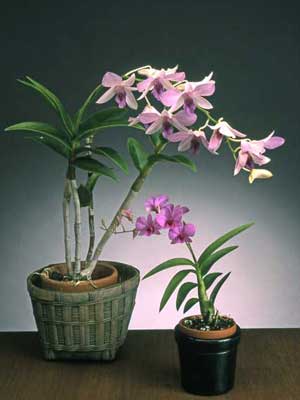
Dendrobium is a diverse genus of orchids with different cultural needs. This culture data is for the dendrobiums type of phalenopsis pictured above. They are evergreen with thin, tall stalks (pseudobulbs).
Water
Water your orchids in the morning so that the leaves are dry before night. How often to water depends on the potting media used, the pot type (plastic or clay), and the pot size. Dendrobiums prefer to be in small pots and are generally much taller than the pot is wide. Because they are generally large plants in relatively small pots, watering twice a week is about average. They prefer to be almost dry before watering again.
When watering, put the plant in the sink and use lukewarm water. Don’t use salt-softened or distilled water. Let the water run through the plant for a minute or so. Make sure to let the plant flow away completely.
This is a good time to watch closely at your plant for any indication of insects or disease.
Light
Dendrobiums need a lot of light, but not direct sunlight. A lightly shaded south window is the best. East or west facing windows seems good enough, if bright (avoid direct sun except at the beginning or end of the day).
Temperature
Dendrobiums are able to withstand hot weather if sufficient ventilation and humidity are given. They are best grown when the temperatures reach between 18°C and 24°C during the day and between 13°C and 16°C at night.
Bear in mind that temperatures in proximity to the window on a windowsill will be colder or hotter than your general house temperature.
Fertilizer
Any balanced orchid fertilizer (look at the numbers on the container, 20-20-20, etc.) can be used to fertilize your orchid. Fertilizing weakly (1/4 strength) works satisfactorily for dendrobiums. Once a month, use clear water to clean any accumulated salts from the potting mix.
Tips
Use a shallow tray of pebbles filled with water to increase humidity around your plants. Ensure the pot does not immerse in water because this will rot the roots.
Provide your plants room for air to circulate around them. Crowding of plants can be lead to trouble of insect infestations and fungus. A small fan will help provide a good air circulation around your plants.
When your plant has finished blooming, you can cut the flowering stalk at the point where it emerge from the tall thin pseudobulbs. Do not cut off the tall thin stalk because the new flower stalk will grow from there. Continue watering and fertilizing and within a year a new growth will spike to start the blooming cycle again!
When re-potting, use a small pot; using a large pot will make the growth delay and reduces flowering significantly. Re-pot every two to three years.
